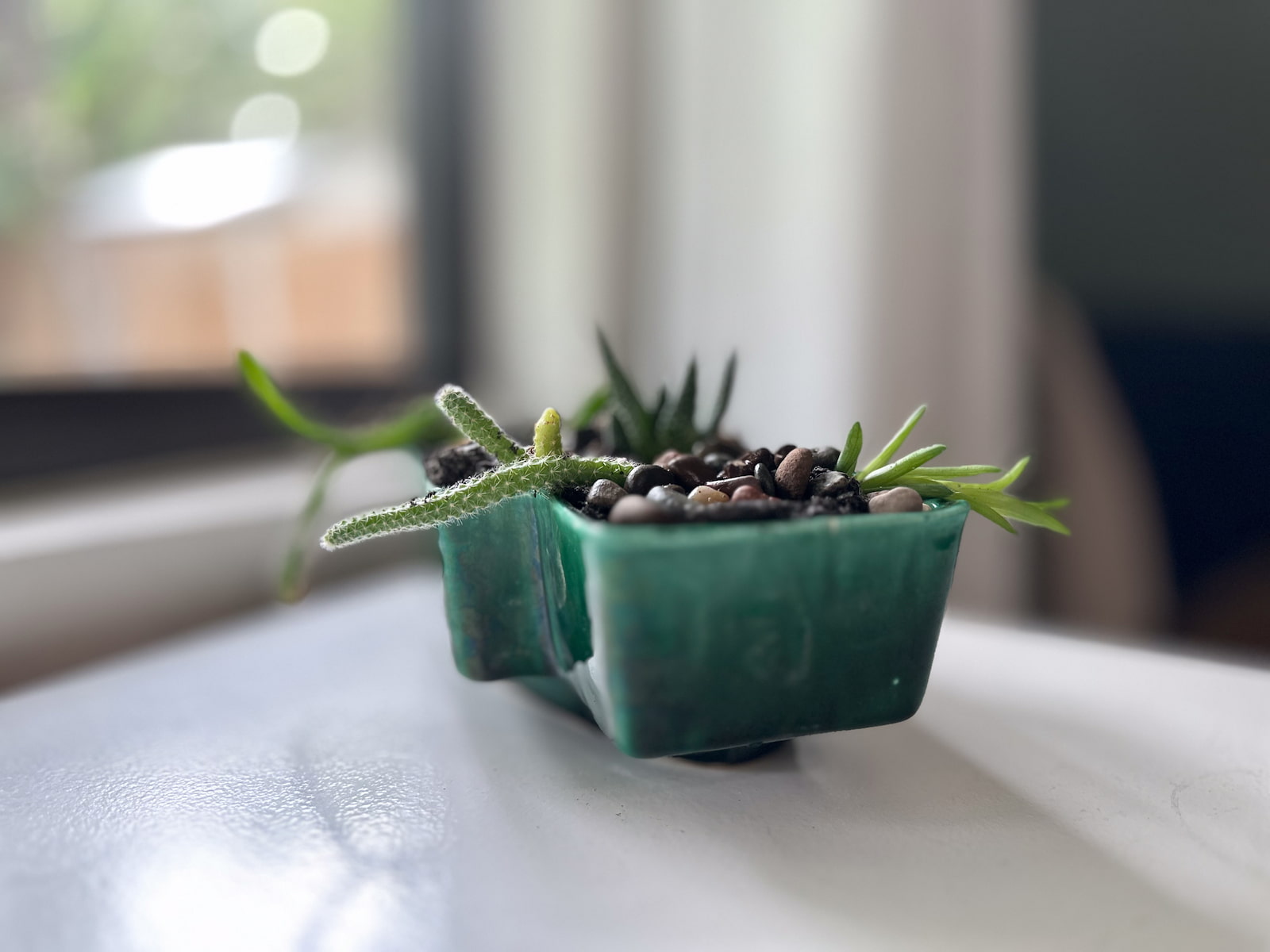Finding and Using Mid-Century Planters for Succulent Gardens
My latest obsession is scouting for interesting mid-century planters at thrift stores and online. I’ve already invited you to my yard for a potting session, but I wanted to share how I hunt for these affordable and eye-catching pots, along with how I use them. It’s indoor plant inspo for you and enabling for me: win, win. While these mid-century planters were often without drain holes and meant for bulbs or to be used as cache pots, I have found they make easy indoor succulent planters.
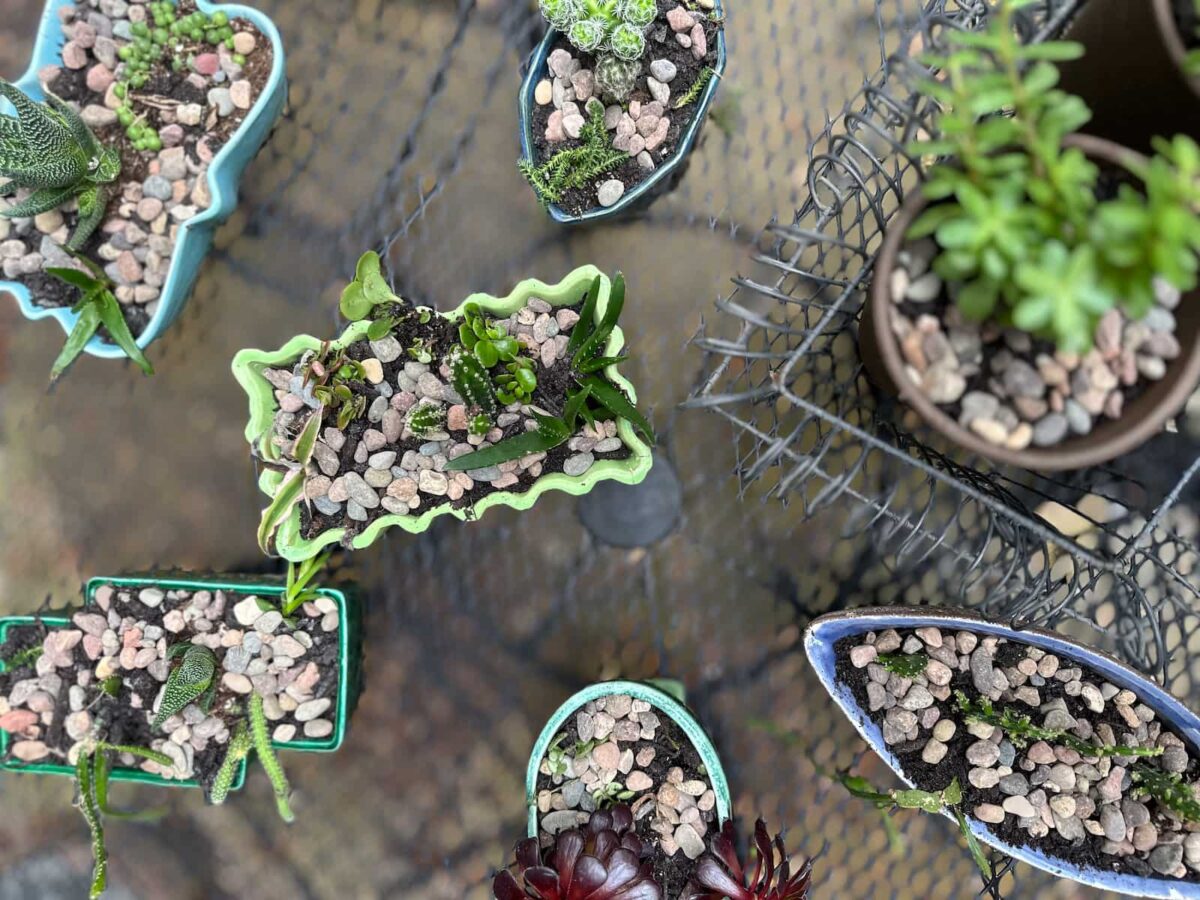
Vintage Planters Make the Most Unique Home Decor
It may take a little digging through resale shops or online vendors, but finding these ceramic planters is worth the effort as they are the perfect size for any interior, are still easy to find, are well made, and come in styles from the utilitarian to the sculptural that suits any decor style. They are compact and often have feet that allow you to water with confidence. Now let’s learn how to find these gems.
Affordable Mid-Century Planters Are Abundant
Forget Fiestaware or Roseville and think thrift village bargain. I get that certain pottery brands are highly coveted and with good reason, but I do like a bargain and appreciate beautiful finds that are still in the realm of affordability for regular folks. Even commonplace companies like McCoy had coveted cookie jars that sent competitors scurrying to copy and now have collectors scurrying to collect and prove authenticity. I say leave the uber-collectibles for the uber-collectors and instead let’s have a little fun hunting for hidden treasures that are still affordable and that you feel okay filling with dirt.
Where To Find Your Mid-Century Planters
These more readily available types of pottery that I mention below feel familiar, probably because most of us grew up seeing them in our grandmother’s or great-grandmother’s homes. They are quirky, fun, and a good way to repurpose home decor, rather than buy more hobby store pottery that tends to be brittle and cheaply made.
Hit the Thrift Stores
If your goal is to repurpose and avoid waste, you’ll definitely want to search local thrift stores for these sweet finds. Get chummy with the workers and ask what is the best time of day to shop for homewares. Most likely, it’s all random luck, but some shops have specific restocking days and the owner might tip you off. Better yet, tell them what you’re looking for and leave a number. They probably won’t bother calling unless they find the mother lode of planters, but it doesn’t hurt to ask.
Don’t Forget to Look In the Kitchenware Section!
Look beyond the outdoor/ pot section of shops because many of these planters look like baking dishes or decorative trays. It’s entirely possible that they could be on the same shelf as Pyrex casserole dishes.
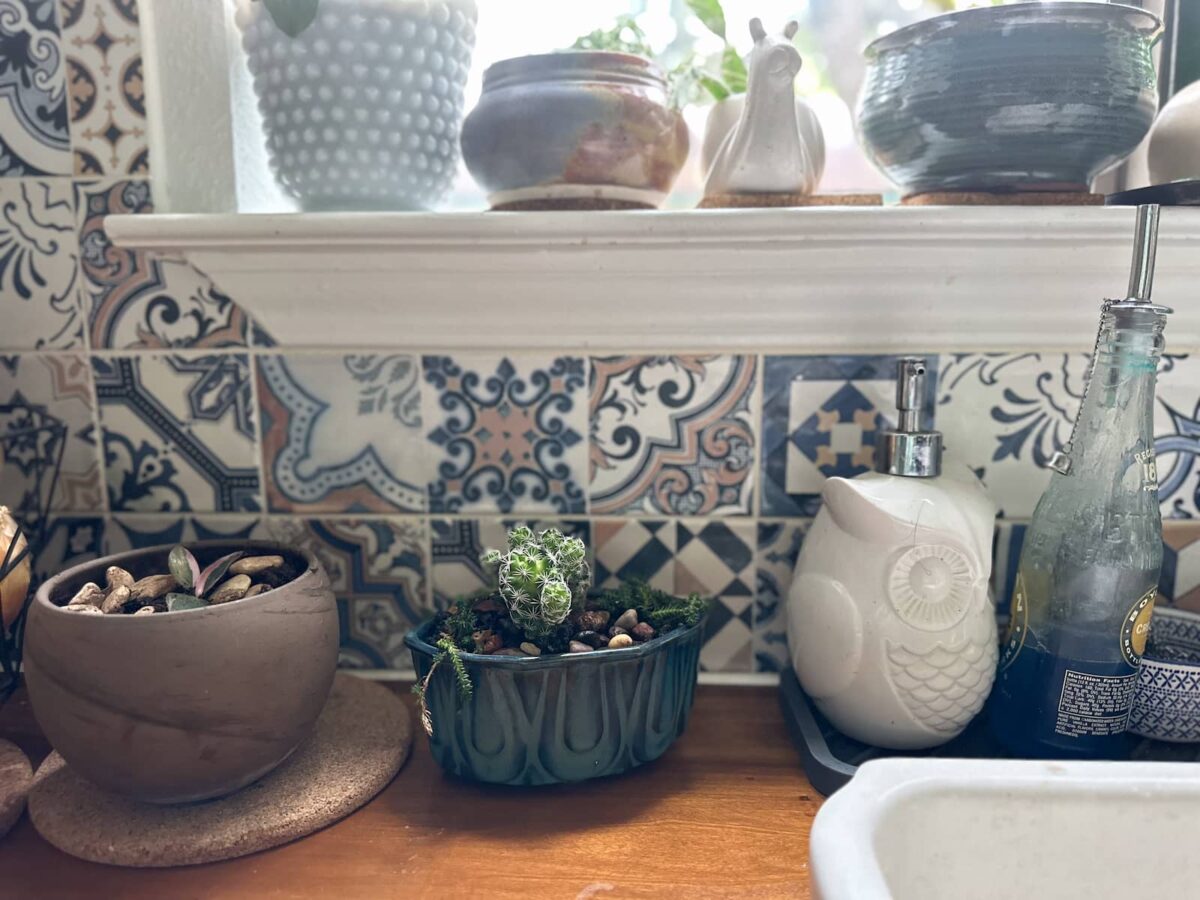
Garage and Estate Sales Can Be a Treasure Trove
If your thrifting excursions prove fruitless, check out garage sales and (especially) estate sales. Though the term “estate sales” has been subverted by serial garage sellers these days, a sale of anyone over 60’s possessions means a high likelihood of finding mid-century pots. I’m not being callous, here. Estate sales are beneficial to the older people who host them or their families and they want you there. (I can also speak from experience in saying that selling a loved one’s things to someone who appreciates them is so much better than seeing it go to a landfill.)
Online Antiques and Collectible Sellers Are Still Affordable
Lastly, there’s the well-reviewed Etsy seller who often has a sale going or will give you a deal on shipping for buying multiples. (I link a few that I’ve noticed at the end of this post.) Consider that you may find multiples in a shop whose owner has a good eye. Sometimes just favoriting an item and waiting a day can lead to the seller contacting you with a discount code.
The downside to a seller’s keen eye and good taste is that they may have higher prices. One way to mitigate this is to look at sellers who don’t specialize in mid-century or pottery. They may have your dream planters for an unusually low price. Now that you know where to look, let’s talk about what to look for.

What, Exactly, Are We Looking For?
When shopping for plant pots from this era, or any really, check the underside for manufacturer markings. Let’s look at a few common markings you may find online or in local shops.
Look for These Markings:
UPCO or Ungemach: The Ungemach Pottery Co planters were the ones that first reeled me in. After tons of browsing for planters (I love to browse, even when I know I won’t buy.) on Etsy and in thrift stores, I think these are my overall favorite type of planter. They also have some of the most fun retro and geometric shapes of any mid-century planters I’ve seen: from rectangular to butterfly styles.
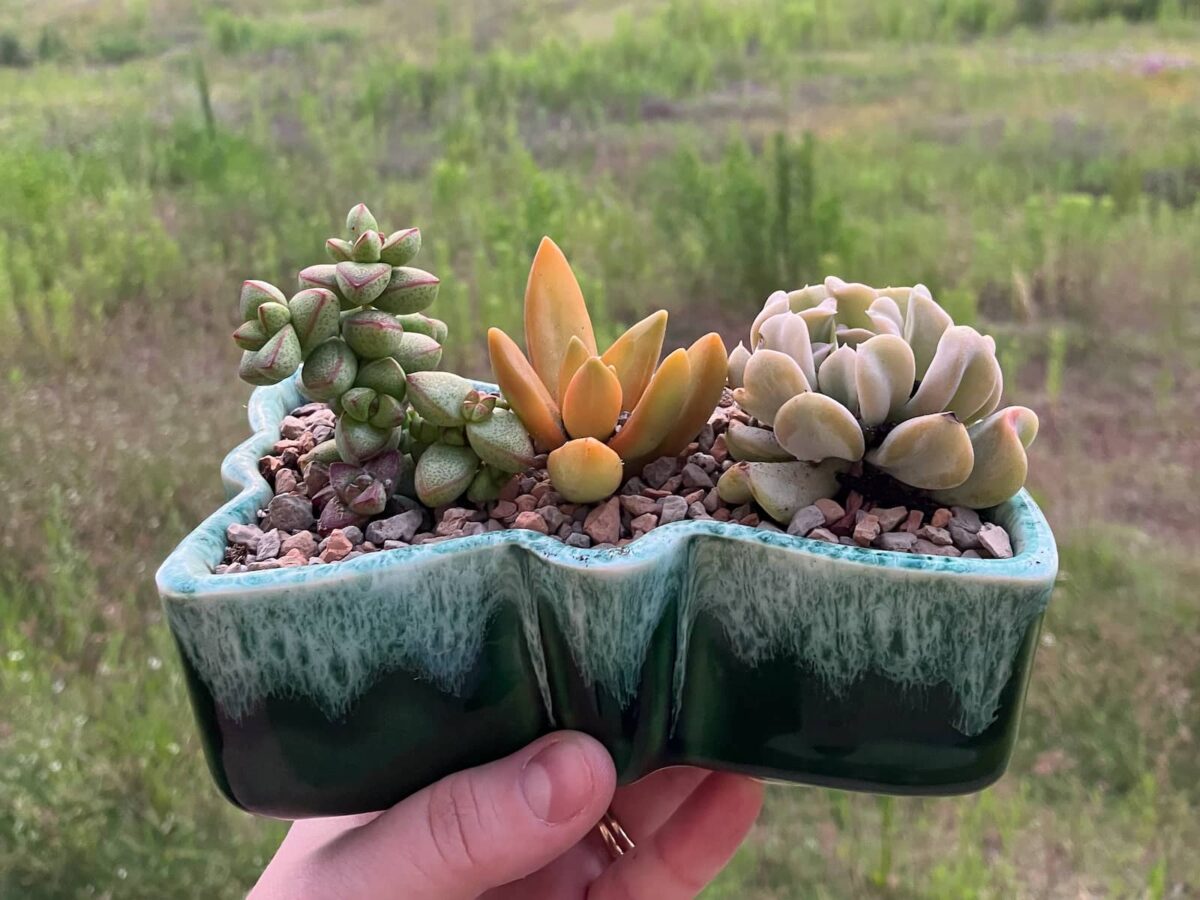
CP or Cookson: Cookson Pottery USA is like McCoy planters I see for sale. They tend to have a bit more of a flourish. Normally I would shy away from overly decorative planters, but both do a mean ornate geometric-shaped pot. Whether it is a stacked brick design or an Art Deco rectangle with an arch detail, they are beautiful with drip glaze or a quirky speckled finish.
Haeger USA: This mark is often accompanied by a number or a sticker label that further identifies the maker and style. The Haeger pieces I see on Etsy are truly all over the place style-wise. There is something for every decor style and much of it is under $50. There are scallop planters, shiny drip glaze rectangular shapes, art deco arched planters, traditional urns, and bright, retro turquoise saucer shapes. Check out this one my daughter gave me to plant with her. See what I mean by scallops and arches?

McCoy: The distinctive “McCoy” script marking on the bottom is such a sharp typography design. I want to find one of these pieces, just for the satisfaction of turning it over and seeing that pleasing signature. Though you may have heard McCoy pieces can be pricey, you were probably hearing about highly sought-after items like cookie jars or large urns and vases. Humble little planters are still abundant with resellers and thrift stores and have such great lines.
Hull or Hull Art USA: These markings are in script or big block letters marking the midwestern Hull pottery that thrived in the 40s and 50s and was best known for its vintage Old Spice containers. Most of the samples I’ve seen online are more decorative than UPCO and often have scalloped edges or fluting.
Stanford Sebring O: Long planters from this Ohio company are super dramatic as a centerpiece to a long dining table or coffee table. They often feature bullet shapes and “atomic” designs you can immediately relate to an era obsessed with the space age.
Just a big “USA”: These could be from one of several pottery companies in the 40s to 60s. If there is also a number on the bottom, you can easily run a search on Etsy and find other pots from the same maker on sale and so identify it. My daughter has a couple of these that she bought with plants from a local vintage seller and I’ve identified them as styles sold by California Pottery.
Calif, as in California Pottery is a common marking for this brand. It’s usually preceded by a style number.
Identifying My Mystery Planter
I inherited a mystery planter with a large “”p-14-Calif USA” marking on the bottom. A quick search online confirmed the “calif” stood for California Pottery, but I was mystified by the glazing technique or lack of it on the outside of the pot. None with the P-14 marked pots looked like mine with its shiny dark green glaze that looks so great in my bedroom. The outside, however, is matte black with streaks of gold in it.


After searching for clues as to what this treatment was called, I realized who I was dealing with. Decor trends for my grandparents’ generation were few and far between. They weren’t scrolling Instagram looking for ways to feel dissatisfied with what they have and for an excuse to get more. When they wanted a change, they often faked it … as in faux paint effects.
That strange matte exterior was probably a wash they applied, during their faux bronzing/ antiquing phase, to the planter — much like the faux antique green and black paint wash lots of people applied to finished wood furniture at the time.
When I inspect it closely, it is indeed paint and I can’t imagine a pottery company painting over their glaze this way. The fact that the paint covered even the feet of the pot was another clue. In the day, a designer may have found it hideous, but that fact makes it incredibly sentimental and excellent to me.
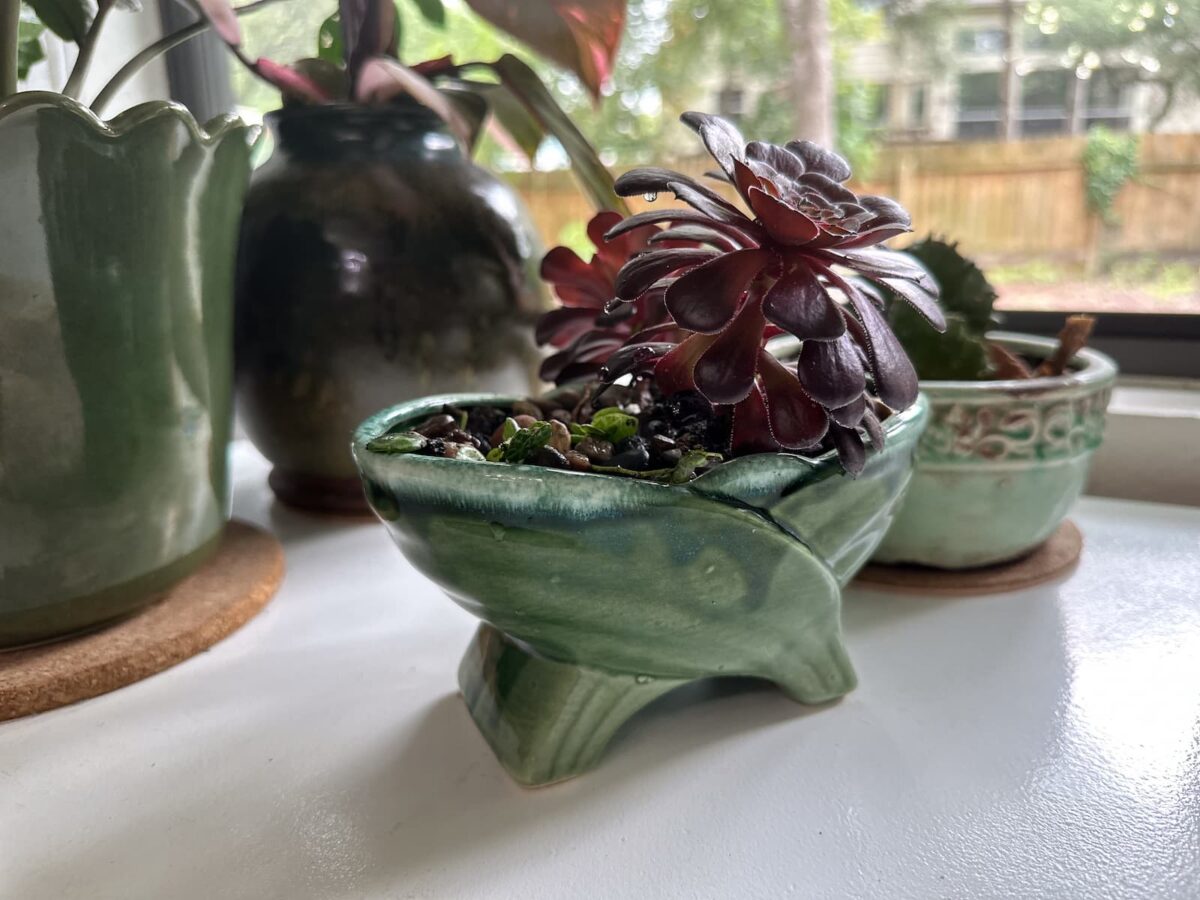
So now I have identified all of my vintage pots and filled them all with succulent lovelies except that bronzed one, which just holds the colors of the Pedernales — basically rocks I picked out of that river — because I don’t want to cover up the green.
What If I Can’t Find Vintage Planters?
This is where things get really fun and quirky. I’m no thrifting purist. I’m okay with recent finds, name brands, and homemade pots that look a little wonky. However, certain mid-century planters consistently delight me and are often much more affordable than their new or handmade counterparts.
If your thrift Village doesn’t have any recognizable ceramic planters, you can still make your own from the ceramics they do have. Favorite stand-in planters I’ve seen or made in the past include a glazed pie pan turned baby succulent garden, an antique crock turned indoor tree pot, a vase turned pink princess philodendron pot, a teapot as a planter, broken teacups as starter pots, and (my favorite) a seashell as a planter.

Keep depth in mind. even a simple baking dish can be a planter for smaller succulents before moving them to larger planters outside. A large saucer or oblong planter makes a fantastic centerpiece for all of those babies your growing succulent will sprout.
Where to Find Succulents on a Budget
This is my favorite part of the process. I could spend all day at a local succulent store but I try not to go more than once or twice a year because I don’t want to destroy my budget.
Look For Plant Babies on Clearance in Stores
Succulents are the cheapest and easiest type of indoor garden to have where I live. Maybe it is due to the central Texas heat, but even high-price nurseries have greenhouses full of tiny, baby succulents for under $5 each. (I list resources at the end.) However, even a local grocery store with an outdoor department has native succulents for $1.50 each. They are small and perfectly sized for shallow containers.
Of course, most plant stores have a clearance rack of less healthy plants that are half price and these are usually easy to nurse back to health. Even if there’s no official clearance cart, ask employees, and they’ll happily tell you where the cheap less- desirables are located. They may even bring some that were headed to the trash bin out for you.
Get to Know Your Neighbors
If you’ve already blown through your plant budget (and I do feel you) scout your neighborhood for yards with thriving succulents. So many people love to talk landscaping and would probably love to divide a few of their plants to make room in their yard, knowing the excess was going to an admirer. Just a friendly conversation netted me several native plants that are now thriving in my backyard — and I didn’t even ask for any!
This is an especially good tip in the early spring when everyone is out weeding and thinning the garden. You may even see excess succulents thrown to the side of the road in a gardening frenzy.
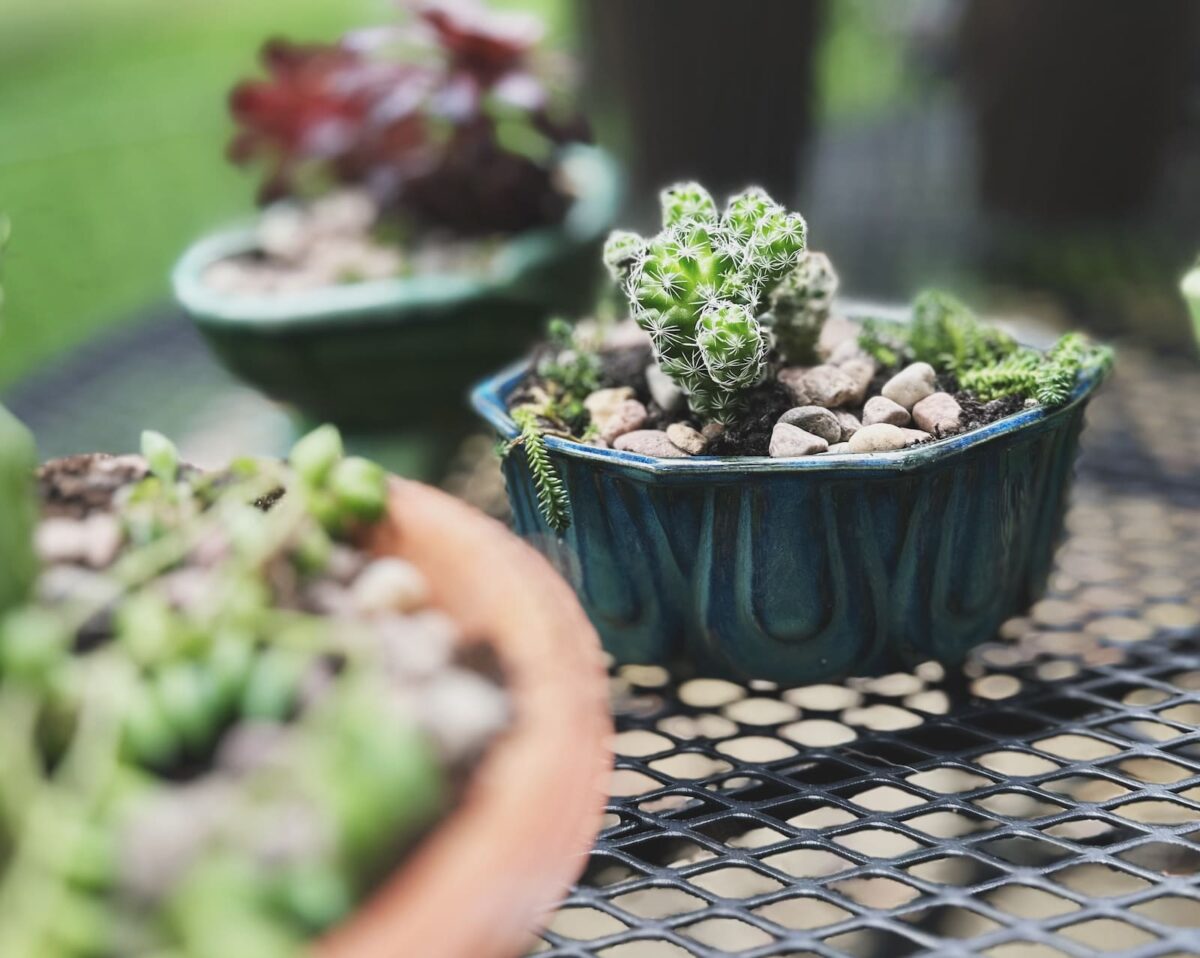
Don’t Forget To Thin Out Your Old Plants
Your own patio plants or garden may have a lot of the plants you need for these planters. Outdoor succulents in warm climates can reproduce like mad and these pups are the right size for a smallish indoor container.
So You’ve Got Your Planter and Plant, Now What?
I let you in on my big planting secrets in my First Person Maker video on these planters. Basically, there is no great secret. Just keep in mind that I lean toward doing things the laziest way possible. I have curated my plant collection to the ones that are okay with my lazy ways.
Like All Thrifted Items, Wash It
Dish soap and water are probably enough to clean your planter, but if there’s any sign of dirt or old plant matter, adding some white vinegar to your pot and letting it soak a few minutes will get rid of any previous plant fungus or pests in soil that may be in the pot.
Use Succulent Soil … or Don’t
Though some gardeners add perlite, pumice, charcoal, or clay to their soil to aerate it, I just use regular potting soil. These plants don’t usually stay in these containers for years, so they are transplanted when they grow too large and new plants move in with fresh soil. I’ve never had a problem with any having compacted soil. (except for African Violets that seem to need only clay pellets … sigh.)
Line the Bottom of Planters for Drainage
What I have done, especially in planters without drainage holes, is put a good layer of gravel or calcined clay (when I go to Ikea I pick it up by the bagfuls) Then I do not water more than once a week. If my plants don’t get much sun indoors, I water them even less often.
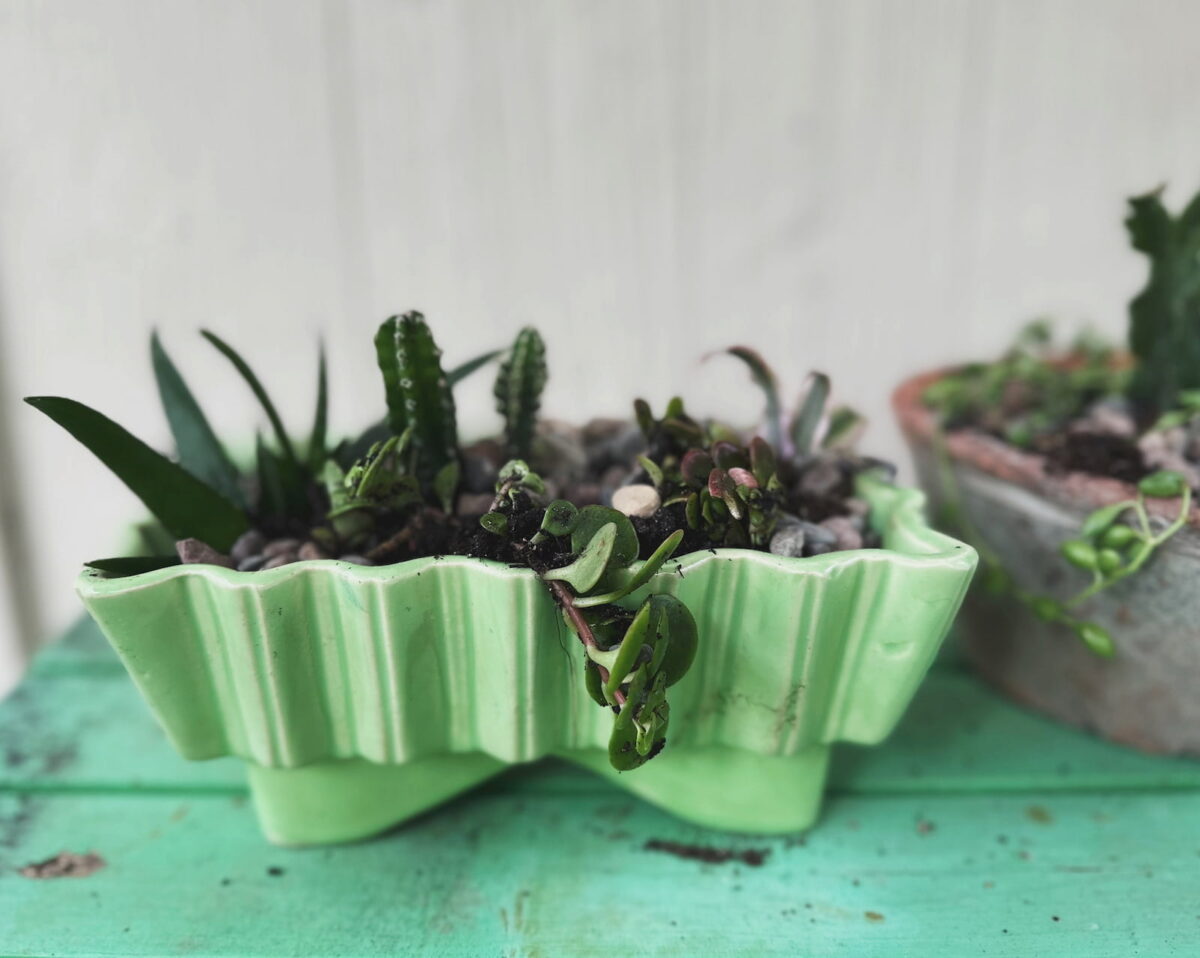
Craft Your Perfect Planter With Varied Shapes and Colors
Honestly, I’m not always super artful in the way I plant things. Sometimes I just want to get things in the dirt and choose the pot closest to me. With indoor plants, however, I make more of an effort because these compact gardens can heavily impact the feel of a room.
I try to consider the color of the planter in my room, then the colors of the plants that will go into it. Beyond the choice of vibrant contrast or monochromatic moodiness, I also look for surprising combinations of shapes. For instance: combining a square planter a trailing, curving Monkey Tail Cactus, or several round Lithops planted in a long, narrow planter.
Water and Feed the Lazy Way
My use of fertilizer is very spotty, maybe once a year I use spikes or sprinkle pellets on everything I own. Because shallow planters like these have plants rotating in and out more often, they don’t need fertilization. This is why I love them. I water once a week, or every two weeks depending on the plant, and that is that.
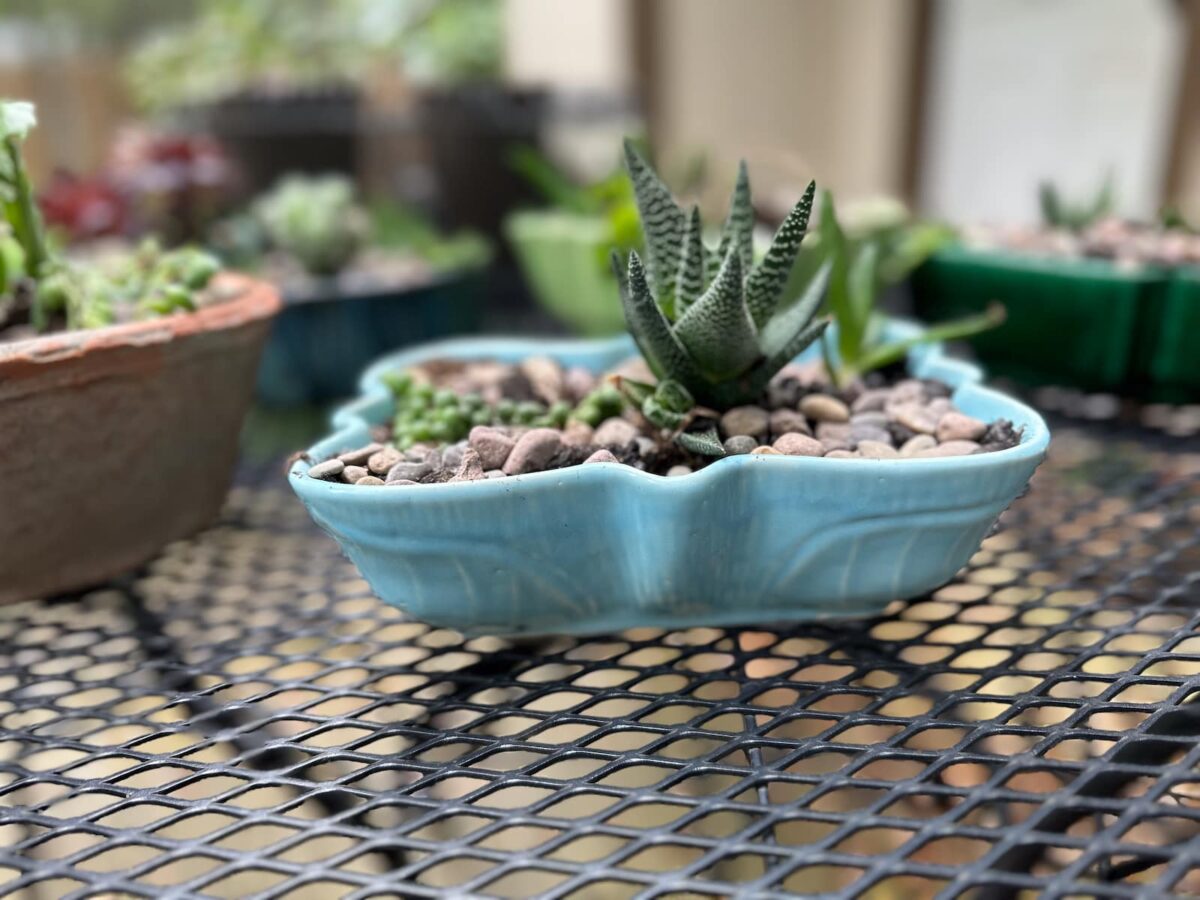
Plans B, C, etc for My Planters
Most of these little babies are plant types I know that I can successfully grow indoors, in a sunny window or I just wouldn’t bother. But I didn’t always know what works for me and I am still experimenting with a few in these pots pictured.
Plan A: Everything works as expected and these green guys thrive and eventually outgrow their pots and get moved to the yard.
Plan B: My plants still have a chance of thriving indoors, I just need to rearrange them to see which ones need the sunniest windows and which will survive without them.
Plan C: They begin to turn yellow and clearly need help, so I move them outdoors and they perk up.
Plan D: Nothing works due to my home’s climate or sunlight deficiency, so I just use the pots as lovely gifts at Christmas to bestow fresh plant babies on all those friends who don’t like plants.
Start Thrifting and Plant Something
Feeling inspired to reuse some cast-off pottery? My response: always. Even when I have a house full of plants, I stroll through the pottery section of Goodwill because these little planters, or other odd finds (like the one below), make great gifts. I get a little therapy out of creating the arrangement and a friend receives a beautiful, unique housewarming gift.
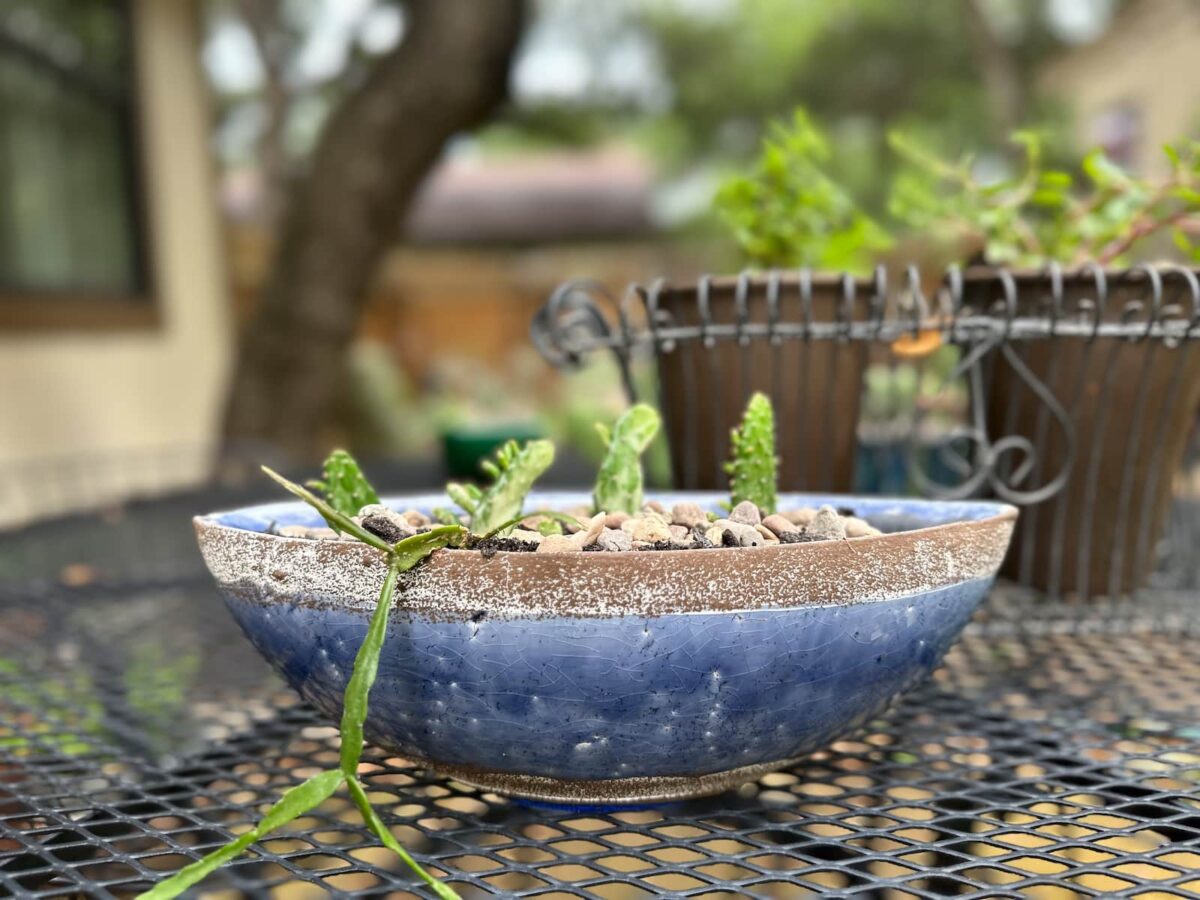
Resources:
- My vintage planter potting session and on the blog
- East Austin Succulents
- The Tillery St Plant Co.
- Daughter of the Wild
- HEB Backyard, Kyle Texas (if you have one of these stores near you.)
- Happy Vintage Studio on Etsy
- Happy Days Gone By on Etsy
- Goodwill Online
- Vintage planter inspo!
A few fun links: I am not alone in my love of green planters.
